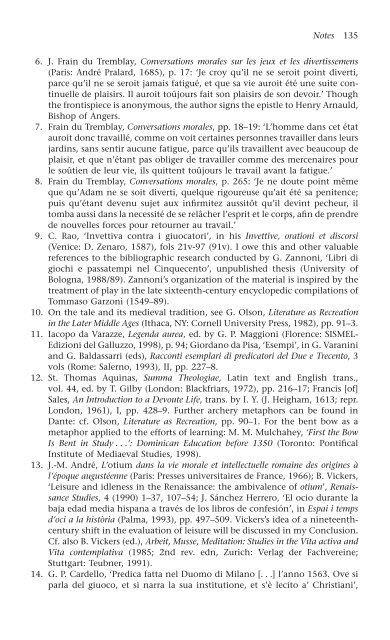Recreation in the Renaissance
Recreation in the Renaissance
Recreation in the Renaissance
- No tags were found...
You also want an ePaper? Increase the reach of your titles
YUMPU automatically turns print PDFs into web optimized ePapers that Google loves.
Notes 135<br />
6. J. Fra<strong>in</strong> du Tremblay, Conversations morales sur les jeux et les divertissemens<br />
(Paris: André Pralard, 1685), p. 17: ‘Je croy qu’il ne se seroit po<strong>in</strong>t diverti,<br />
parce qu’il ne se seroit jamais fatigué, et que sa vie auroit été une suite cont<strong>in</strong>uelle<br />
de plaisirs. Il auroit toûjours fait son plaisirs de son devoir.’ Though<br />
<strong>the</strong> frontispiece is anonymous, <strong>the</strong> author signs <strong>the</strong> epistle to Henry Arnauld,<br />
Bishop of Angers.<br />
7. Fra<strong>in</strong> du Tremblay, Conversations morales, pp. 18–19: ‘L’homme dans cet état<br />
auroit donc travaillé, comme on voit certa<strong>in</strong>es personnes travailler dans leurs<br />
jard<strong>in</strong>s, sans sentir aucune fatigue, parce qu’ils travaillent avec beaucoup de<br />
plaisir, et que n’étant pas obliger de travailler comme des mercenaires pour<br />
le soûtien de leur vie, ils quittent toûjours le travail avant la fatigue.’<br />
8. Fra<strong>in</strong> du Tremblay, Conversations morales, p. 265: ‘Je ne doute po<strong>in</strong>t même<br />
que qu’Adam ne se soit diverti, quelque rigoureuse qu’ait été sa penitence;<br />
puis qu’étant devenu sujet aux <strong>in</strong>firmitez aussitôt qu’il dev<strong>in</strong>t pecheur, il<br />
tomba aussi dans la necessité de se relâcher l’esprit et le corps, af<strong>in</strong> de prendre<br />
de nouvelles forces pour retourner au travail.’<br />
9. C. Rao, ‘Invettiva contra i giuocatori’, <strong>in</strong> his Invettive, orationi et discorsi<br />
(Venice: D. Zenaro, 1587), fols 21v-97 (91v). I owe this and o<strong>the</strong>r valuable<br />
references to <strong>the</strong> bibliographic research conducted by G. Zannoni, ‘Libri di<br />
giochi e passatempi nel C<strong>in</strong>quecento’, unpublished <strong>the</strong>sis (University of<br />
Bologna, 1988/89). Zannoni’s organization of <strong>the</strong> material is <strong>in</strong>spired by <strong>the</strong><br />
treatment of play <strong>in</strong> <strong>the</strong> late sixteenth-century encyclopedic compilations of<br />
Tommaso Garzoni (1549–89).<br />
10. On <strong>the</strong> tale and its medieval tradition, see G. Olson, Literature as <strong>Recreation</strong><br />
<strong>in</strong> <strong>the</strong> Later Middle Ages (Ithaca, NY: Cornell University Press, 1982), pp. 91–3.<br />
11. Iacopo da Varazze, Legenda aurea, ed. by G. P. Maggioni (Florence: SISMEL-<br />
Edizioni del Galluzzo, 1998), p. 94; Giordano da Pisa, ‘Esempi’, <strong>in</strong> G. Varan<strong>in</strong>i<br />
and G. Baldassarri (eds), Racconti esemplari di predicatori del Due e Trecento, 3<br />
vols (Rome: Salerno, 1993), II, pp. 227–8.<br />
12. St. Thomas Aqu<strong>in</strong>as, Summa Theologiae, Lat<strong>in</strong> text and English trans.,<br />
vol. 44, ed. by T. Gilby (London: Blackfriars, 1972), pp. 216–17; Francis [of]<br />
Sales, An Introduction to a Devoute Life, trans. by I. Y. (J. Heigham, 1613; repr.<br />
London, 1961), I, pp. 428–9. Fur<strong>the</strong>r archery metaphors can be found <strong>in</strong><br />
Dante: cf. Olson, Literature as <strong>Recreation</strong>, pp. 90–1. For <strong>the</strong> bent bow as a<br />
metaphor applied to <strong>the</strong> efforts of learn<strong>in</strong>g: M. M. Mulchahey, ‘First <strong>the</strong> Bow<br />
Is Bent <strong>in</strong> Study . . .’: Dom<strong>in</strong>ican Education before 1350 (Toronto: Pontifical<br />
Institute of Mediaeval Studies, 1998).<br />
13. J.-M. André, L’otium dans la vie morale et <strong>in</strong>tellectuelle roma<strong>in</strong>e des orig<strong>in</strong>es à<br />
l’époque augustéenne (Paris: Presses universitaires de France, 1966); B. Vickers,<br />
‘Leisure and idleness <strong>in</strong> <strong>the</strong> <strong>Renaissance</strong>: <strong>the</strong> ambivalence of otium’, <strong>Renaissance</strong><br />
Studies, 4 (1990) 1–37, 107–54; J. Sánchez Herrero, ‘El ocio durante la<br />
baja edad media hispana a través de los libros de confesión’, <strong>in</strong> Espai i temps<br />
d’oci a la història (Palma, 1993), pp. 497–509. Vickers’s idea of a n<strong>in</strong>eteenthcentury<br />
shift <strong>in</strong> <strong>the</strong> evaluation of leisure will be discussed <strong>in</strong> my Conclusion.<br />
Cf. also B. Vickers (ed.), Arbeit, Musse, Meditation: Studies <strong>in</strong> <strong>the</strong> Vita activa and<br />
Vita contemplativa (1985; 2nd rev. edn, Zurich: Verlag der Fachvere<strong>in</strong>e;<br />
Stuttgart: Teubner, 1991).<br />
14. G. P. Cardello, ‘Predica fatta nel Duomo di Milano [. . .] l’anno 1563. Ove si<br />
parla del giuoco, et si narra la sua <strong>in</strong>stitutione, et s’è lecito a’ Christiani’,










